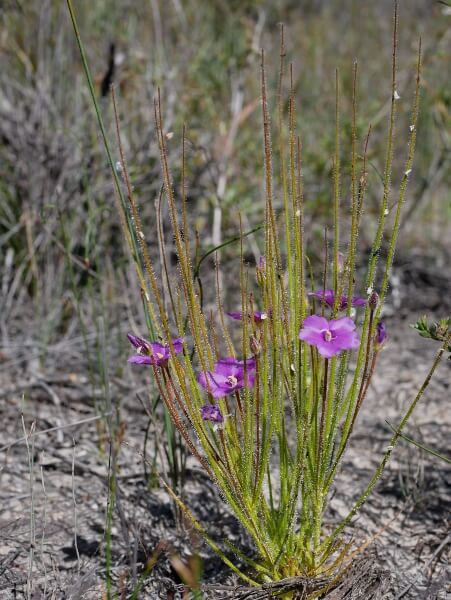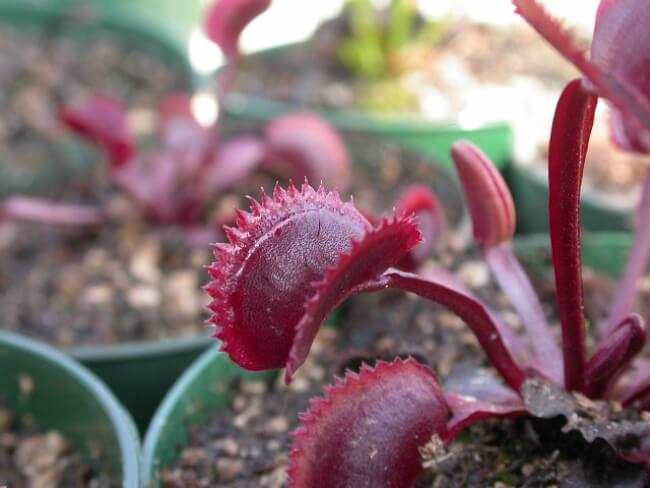Carnivorous plants are a fascinating insight into the evolution of the world. Most will feed on insects, hence their other name – insectivorous plants – but some feed on soil life like nematodes, and actively improve the conditions for other plants to thrive.
Today, carnivorous plants are mostly cultivated as a method of household pest control, or to bring a smile to young gardeners. Understandable, as they bring a smile to the faces of old gardeners too.
But rather than look at insectivorous and carnivorous plants in passing, and share the same joys as usual, we thought we’d look at a few select species (there are hundreds) and dive into their benefits to us, and how we as gardeners can help them to thrive.
More...
What are Carnivorous Plants?
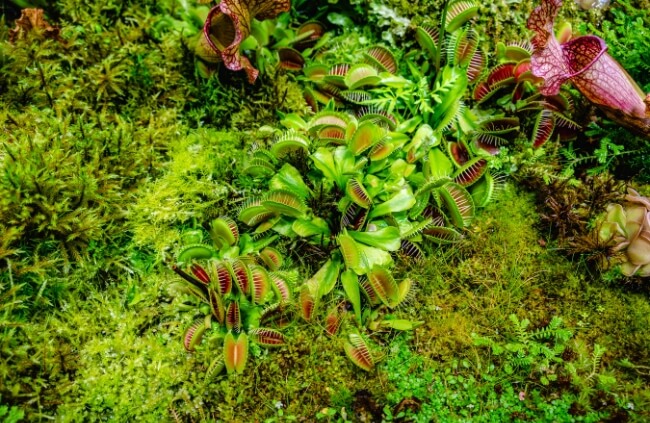
99.9% of carnivorous plants feed on insects, but a handful are so large that they can feed on small birds and rodents too. Essentially, they get moisture from the soil, and energy from photosynthesis, but most of their nutrients come from the prey they catch and kill, typically by luring them with either the appearance or scent of rotting flesh.
Some are slightly more pleasant to have at home, producing sugary nectar, which attracts insects for a quick meal and traps them in the sticky sap. There are over 750 distinct species of true carnivorous plants (meaning they actively seek to eat insects or small animals, rather than passively ingest them).
Some partially carnivorous plants, like many species of bromeliad, store pools of water and benefit from naturally decaying lifeforms, but do not rely on it.
What is the Function of Carnivorous Plants?
Carnivorous plants’ only true function is to feed themselves and multiply, but they are useful in our homes, and in nature as a passive pest controller. They help to limit problem insects in our gardens, and control houseplant pests too.
Some carnivorous plants, like oyster mushrooms, feed on soil life including nematodes, to build wider and stronger mycelium networks, which supports the development of forests. As trees develop, their root systems (connected intrinsically to the fungal mycelium network) actively benefit the mushrooms. In that quite a particular case, there is a symbiotic relationship between the carnivorous plant and its host.
Some epiphytic carnivorous plants (pitcher plants in particular) help to control pest species around their host trees too, with a similar symbiosis.
How and Where Do Carnivorous Plants Grow Best?
Carnivorous plants are a relatively small group of genera, some with hundreds of species, and others with just two or three. Most grow in tropical and subtropical climates, but others grow well in mild climates around Northern Europe.
The only shared characteristic across nearly all carnivorous plants, is that they require reasonably high humidity and moist soil conditions. Each genus differs slightly, but they can mostly be grown well around pond edges, in bog gardens, or in damp, potted conditions.
Carnivorous Plants to Grow in Australia
There are over 750 species of carnivorous plants in the world, split into about 20 genera. About twenty of those plant groups are commonly grown house and garden plants, with varied cultivars of each.
Below, we focus on the genera that make the most useful plants for us as gardeners, including some naturally occurring species, and a few hybrids and bred cultivars.
Pitcher Plants (Sarraceniaceae)

‘Pitcher plants’ most commonly refer to the plant family Sarraceniaceae, but also to Cephalotaceae, Bromeliaceae. We’ll split a fourth, Nepenthes (the Monkey Cup Plant) into a separate group below as they grow in different conditions.


Get Your Free Guide:
Master Growing Australian Natives eBook
A Must Have Complete Guide for Every Australian Garden
Get Your Free Guide:
Master Growing Australian Natives eBook
A Must Have Complete Guide for Every Australian Garden
There are three separate genera in this family; Sarracenia, Darlingtonia, and Heliamphora. All are carnivorous plants, and all are native to the Americas.
Western Australian Pitcher Plant (Cephalotus follicularis)

This native carnivorous plant is a commonly collected insectivorous plant, with distinct ridges around the openings of its deep cups. The lid of each cup lowers down to trap insects, but hairs inside also prevent those who enter from escaping.
Deep burgundy cups, with evenly spaced green ridges are the easiest way to identify this moisture-loving carnivorous plant, which grows best in a mix of leaf mould and sphagnum moss.
Also known as Albany pitcher plant, is the only surviving species in this genus (Cephalotus), and thankfully very widespread throughout Western Australia, meaning it is not in danger of extinction, and can be found in garden centres and online as a houseplant or bog plant for our gardens.
They can survive on sandy or swampy soils, provided they are kept consistently moist and are beautifully distinct with their crimped caps and fluffy cups.
(In the past, we recommended using peat/sphagnum moss. However, given its environmental impact, we have shifted our guidance to less impactful alternatives that are just as good or if not better. Check out our guide if you want to learn more about peat moss and its alternatives.)
North American Pitcher Plant (Sarracenia x Brooks hybrid)
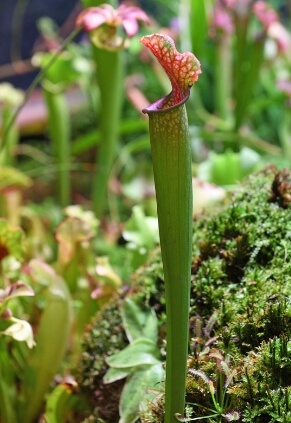
One of the tallest pitcher plants that can easily be cultivated in gardens is the North American pitcher plant. Plant anywhere damp, or in a plastic pot with a saucer beneath to conserve moisture.
Reaching 1 m tall at maturity, its tall cups tower above other plants in a bog garden adding stunning structure and form. In the morning and evening sun, light passes through the cups and lights them up with a spectacular glow, highlighting beautiful red veining on the caps.
Parrot Pitcher Plant (Sarracenia psittacina)
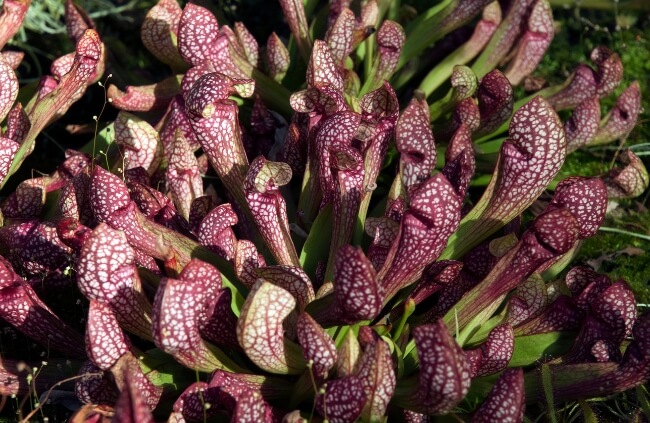
The parrot pitcher plant is a fascinatingly ornamental species of Sarracenia, with tall drooping, waxy, flowers that stand above a flat rosette of curled red pitchers.
This low growing pitcher plant is a beautiful houseplant, but can get lost easily in gardens, so grow it somewhere with space around it, in very damp soils, or even pond borders, where it can happily be submerged through summer.
Corkscrew Plant (Genlisea)

Not to be confused with the non-carnivorous corkscrew rush (also an effective bog and pond plant) Genlisea is a very different type of carnivorous plant indeed.
It produces flowers, and small, tightly bound foliage above ground, but its carnivorous efforts are focussed below the soil surface, where its modified leaves catch and digest small soil life like nematodes rather than taking nutrients from the soil.
These are fascinating plants for bog gardens, and essential for carnivorous terrariums as they help to maintain soil health more generally.
Rainbow Plants (Byblis)
There are just eight species in the Byblis genus, and all are native to either Australia or New Guinea, where they thrive in bogs and marshland. Their flowers are incredibly ornamental, with open translucent groups of five petals, and a typical pollen-filled centre for seed production.
Their fly-trapping ability is limited and relies entirely on attracting flies to sweet, sticky secretions on their wiry, needle-like leaves. Byblis can be grown in pots, or will grow and spread happily in damp, warm, Australian gardens.
Venus Flytrap (Dionaea muscipula)

The most famous of all carnivorous plants is the Venus flytrap. It’s elegant but alien traps are so similar to the mouths of mammals that it’s hard to believe there’s no genetic connection.
There is just one species in the genus Dionaea, D. muscipula. Sadly, it is nearly extinct in the wild, and most of the cultivars sold today are adapted versions of the original plant, which only grows in the nitrogen rich soils of wetlands in North Carolina and South Carolina in the USA.
To conserve energy, Venus flytraps only snap when they have been triggered twice in quick succession. This is to prevent them shutting onto falling leaves, or rain.
Dionaea muscipula ‘Big Mouth’
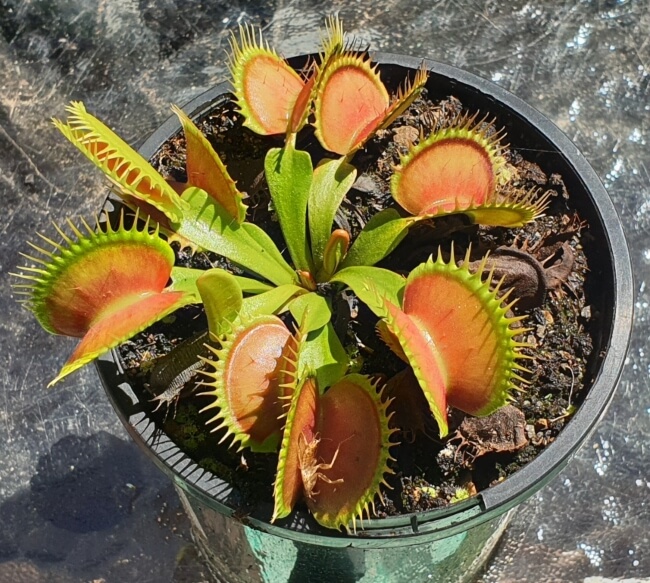
Source: Succulent Flytraps
With deep red mouths, and sappy shoots that passively trap smaller insects, Dionaea is one of the most efficient fly catchers for indoor growing.
It needs consistently moist soil, controlled humidity, and where possible, good access to daylight to support limited photosynthesis.
Dionaea muscipula ‘Red Piranha’
‘Red Piranha’ is a really wonderful cultivar of the Venus flytrap, with stems and traps that start out life as low growing plants that could easily be mistaken for lichens, but that develop into 5-10 cm tall traps, with deep, blood-red wrappings on every part.
Central flowers develop on green stems, which can often seem like a reversion, but is part of a healthy life cycle.
Dionaea muscipula ‘B52’
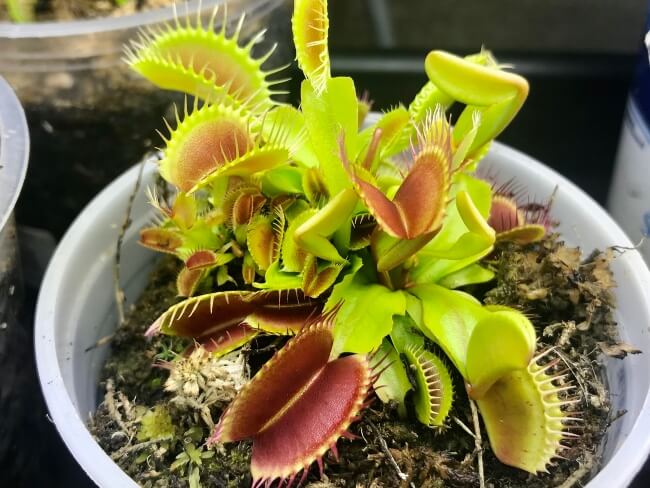
Source: Special Vegetation
One of the largest Venus try traps ever bred is Dionaea muscipula ‘BS2’. They are still fairly small plants, at most reaching 10-15 cm tall, but with huge individual traps, easily capable of eating large flies, and making a beautiful statement plant, particularly indoors.
Dionaea muscipula ‘Cupped Trap’
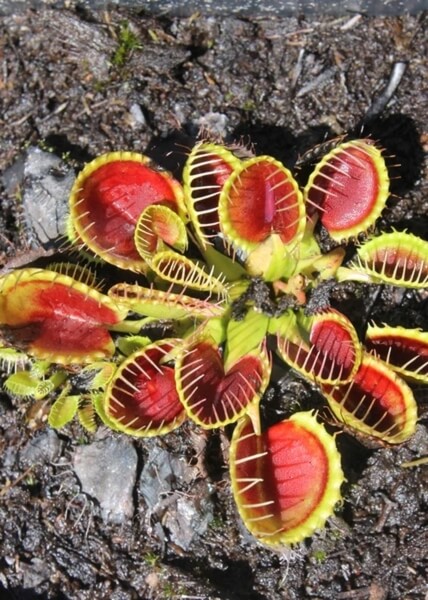
Source: Plant Delights Nursery
Another readily available cultivar of the Venus fly trap is the Dionaea ‘cupped trap’ or Dionaea ‘cup trap’, with unusually rounded traps. They are incredibly low growing, but dense plants, with dozens of traps on each rosette.
In time, healthy plants can be divided to make new Venus fly traps for other parts of the house. All will need moisture retentive compost mixed with sphagnum moss.
Dionaea muscipula ‘Petite Dragon’

Source: Carnivorous Plant Resource
One of my favourite plants at home is Dionaea muscipula ‘Petite Dragon’. It’s a vigorous Venus fly trap, which spreads out beautifully to create a flowing mat of crimson traps.
Dionaea ‘Petite Dragon’ will never grow taller than 2-3 cm, until it flowers, producing subtle but fascinating flowers that are pollinated by flies, before coaxing them into the traps as food.
Cobra Lily (Darlingtonia californica)
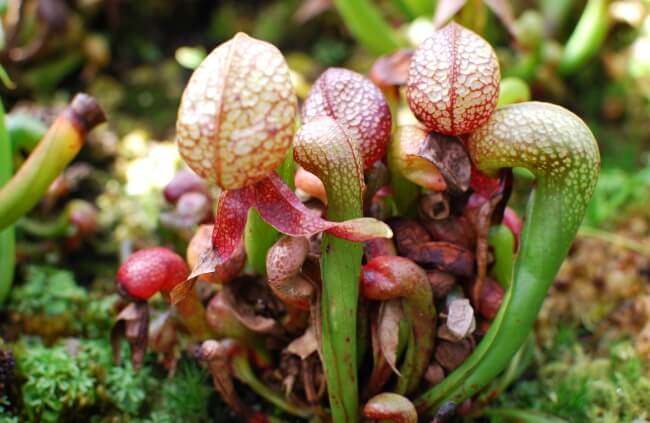
The California pitcher plant is very distinct from others in the Sarraceniaceae family, taking its common name, the Cobra lily, from its arching, curved cups, with flaring caps and red veining that looks incredibly like the flicking tongue of a snake.
Personally, if I was a fly, I’d steer well clear, but that doesn’t seem to stop it from being one of the most successful carnivorous plants on the earth. Like other tall species of pitcher plants, it glows in the morning or evening sun, when the sun filters through the thin membrane of each pitcher.
Butterwort (Pinguicula)

Butterworts are beyond beautiful. Their tight rosettes are made up of neat succulent leaf patterns, similar to Sempervivums or Aeoniums, but distinct in that they produce copious amounts of sticky sap to trap their prey, and digest them right there on the leaf surface.
One important thing to remember when growing butterworts is not to trigger them by brushing their leaves. Each gland can only digest and run through the trapping routine one time. As the plant develops, having trapped and digested enough insects it expands to create new leaves and repeat the process.
The viola-like flowers develop from central stems at the centre of each plant, and produce seeds, which can be collected and propagated in damp compost.
Pinguicula agnata ‘Red Leaf’
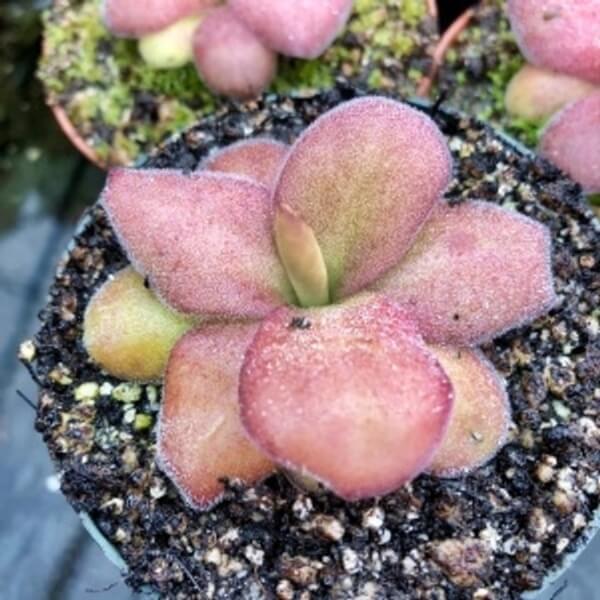
Source: Sarracenia Northwest
Excessive levels of anthocyanin in the leaves of Pinguicula agnata ‘Red Leaf’ add to the charm of this rotund butterwort, which produces spectacularly multi toned flowers from the centre of its deeply blushed rosette.
Pinguicula ehlersiae ‘Victoria’
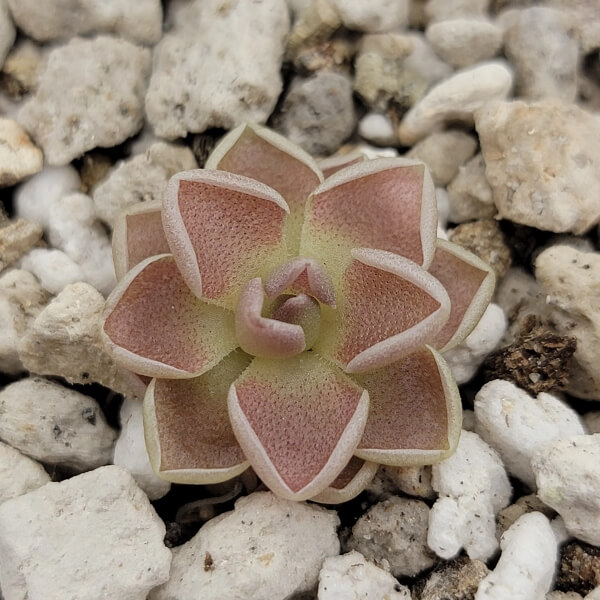
Source: Rainbow Carnivorous Plants
This slow growing butterwort, Pinguicula ehlersiae ‘Victoria’ has impeccable structure, with gorgeously pointed red leaves, each with a silvery-pink underside, adding to the drama of its small form.
Within the cup of each pointed leaf is a copious spread of sticky glands to catch and digest prey.
Pinguicula agnata ‘El Lobo’
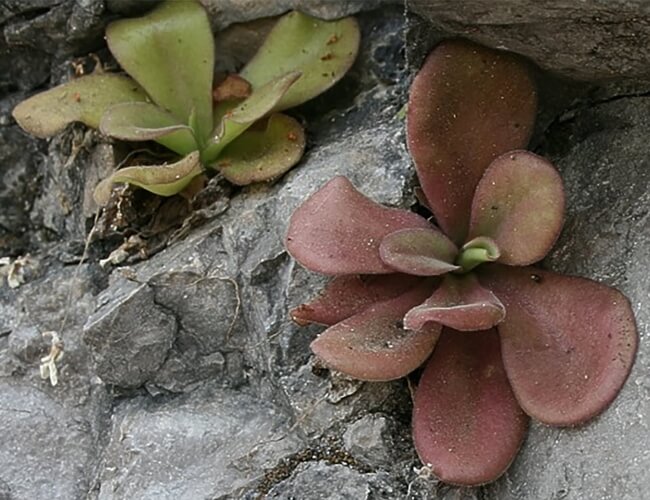
Source: PetFlyTrap.com
Pinguicula ‘El Lobo’ is a really fascinating plant, and responds to varying conditions with varying foliage. Sometimes with elongated leaves, sometimes with green leaves, but in ideal conditions it will have a sunburst pattern from green to red, with some veining on each leaf.
Pinguicula colimensis
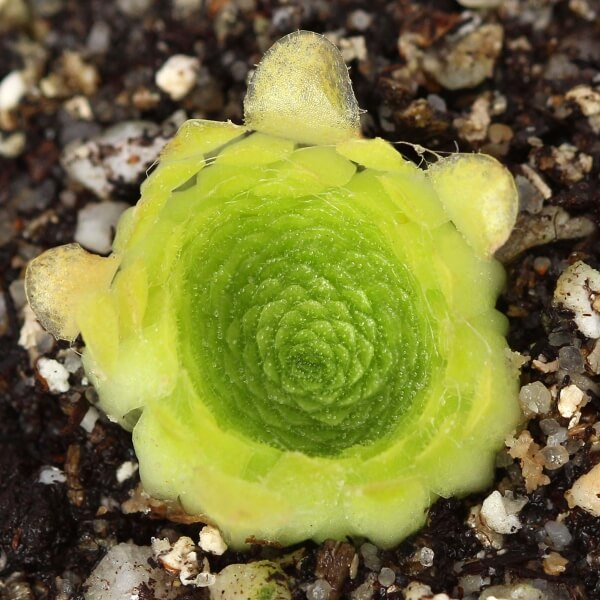
Source: Curious Plant
Mexican butterwort is a brilliant carnivorous plant to grow at home, especially with kids. Like many succulents, it develops pups that can be pricked out with a pencil and planted into fresh soil. Each plant is entirely cup shaped, with incredibly tightly spaced small leaves covering the inside of the cup.
It traps rainwater and insects inside the cup, passively digesting them when they become trapped in the sticky sap. As it develops it can form a brown ring of old leaves, but these don’t do it any harm at all and should be left to drop off in their own time.
Pinguicula gypsicola
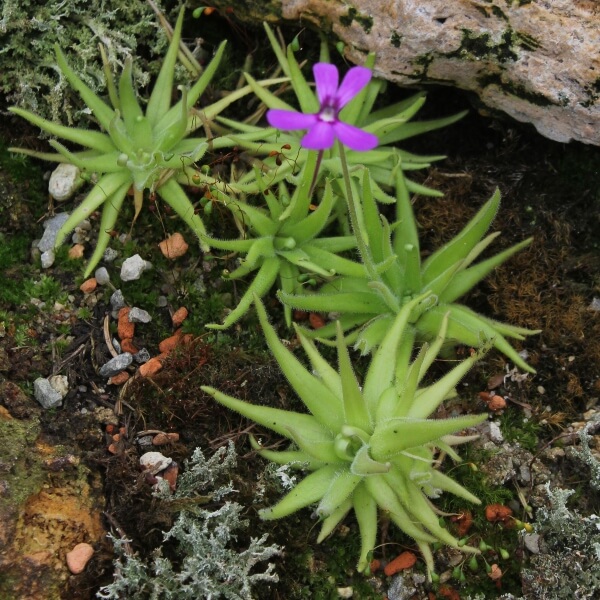
Source: Plant Identification
One unique butterwort is Pinguicula gypsicola, with long, wiry leaves looking more like coral or an anemone than most land plants. They are generally epiphytic or lithophytes in nature, but can be grown on any moist compost, bark, or moss.
Monkey Cup (Nepenthes)
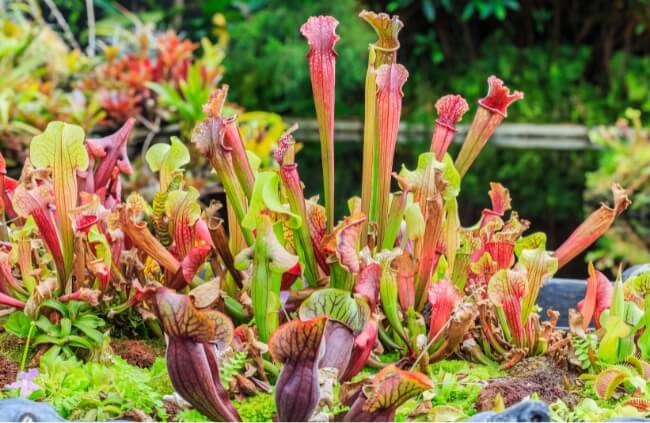
With some species developing stems up to 15 m long, which can climb and cling to trees, monkey cups are a wonderful option for more humid outdoor settings, but make equally wonderful house plants.
Tropical pitcher plants are a group of around 170 species of Nepenthes, and all are carnivorous.
Nepenthes hemsleyana
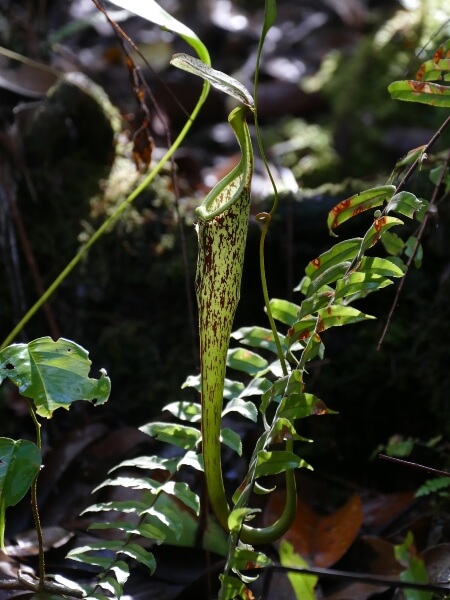
Source: A garden's chronicle
While you might not be able to form the bat pitcher plant at home, it’s certainly one to inspire! This carnivorous plant doesn’t eat bats, it actually forms a beautiful symbiotic relationship with them instead. It can eat insects, and survive on them, but thanks to its large protective cups, it offers a safe home to solitary bats.
The bats sleep in the pitchers, and then go out hunting. When they return, they feed the plant with their droppings – readily processed balls of insects. The plant gets free food, and the bat gets a wonderful place to sleep.
Nepenthes attenboroughii

Source: Wikipedia
The world’s largest carnivorous plant, Nepenthes attenboroughii, has cups that can reach 1/5 m in size, and while it is threatened in the wild, it is possible to find responsibly grown specimens for personal collections.
It feeds on anything from insects to small mammals and is a particularly long-lived carnivorous plant when it has appropriate care and conditions.
Nepenthes mirabilis

A great example of the genus is Nepenthes mirabilis, which is widespread across Southeast Asia and swampy parts of Australia. It will grow anywhere with adequate moisture and light, but needs feeding regularly to keep it healthy.
Nepenthes parvula
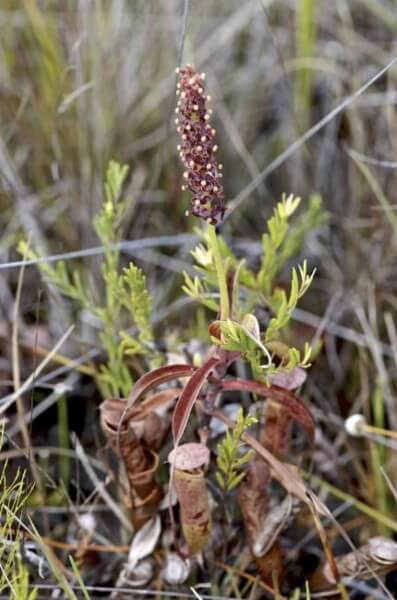
Source: Atlas of Living Australia
One really special native carnivorous plant is Nepenthes parvula, which grows solely in swamps around the Cape York Peninsula. It can grow in most moist conditions, but does best with submersion in swamps and bogs, where it catches pond dwelling insects and flies that land for a drink. Despite thriving in the wild, it is rarely available in cultivation.
Nepenthes ‘Bloody Mary’
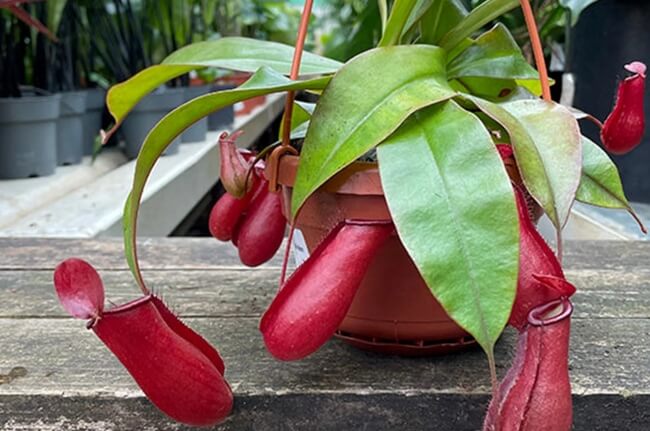
Source: Plants For All Seasons
A great compact cultivar to grow at home is Nepenthes ‘Bloody Mary’, whose bright red pitchers hang neatly from beneath sturdy foliage, making it perfect for hanging baskets or trailing planters.
Its pitchers constantly secrete sweet nectar which actively attracts flies regardless of where it’s planted, but it needs a really moisture retentive potting mix to keep it happy.
Nepenthes tenax
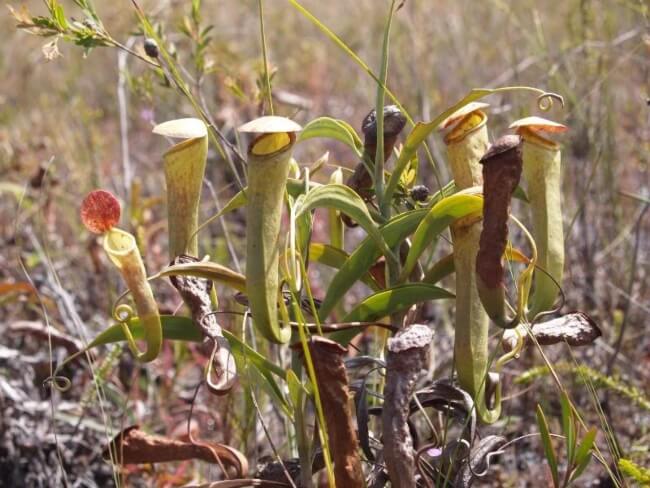
Source: IDSeeds Farm
For the more serious collectors, Nepenthes tenax is particularly desirable, thanks to its dazzling red caps, and elongated curved cups, which stand tall above boggy soils.
It’s not the most attractive pitcher plant in the world, but it’s one of the most effective fly catchers, with each plant hosting at least a dozen pitchers once mature.
Waterwheel Plant (Aldrovanda vesiculosa)
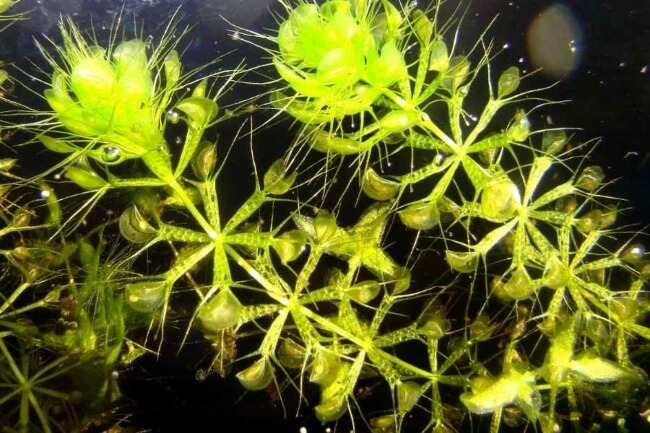
Source: Urbaki
Aldrovanda vesiculosa, if you keep an aquarium with larger-breeds of fish, is a fascinating plant to add to your collection, and one of the only underwater plants to have developed the snapping mechanism of Venus flytraps.
It grows solely in water, and has translucent foliage and traps, which snap shut on any insects that bother it, digesting and processing its food in just the same way as a Venus fly trap.
They are rare, but can be found from specialist and responsible suppliers for serious collectors.
Sundews (Drosera)

Sundews are possibly the widest spread genus of carnivorous plants in the world, growing in a variety of damp conditions from the tropics to the coldest parts of northern Europe.
They are mostly hardy, and relatively easy to grow, sometimes spreading as weeds in damp gardens. Don’t let that put you off though, as they are easy to control, not particularly invasive, and will be a huge help in managing pest species in your garden.
They work through dense secretions on the tips of tiny hairs, which trigger the leaves to wrap in on the trapped prey, to ensure completely that it can’t wriggle away.
As the prey is stuck in the curled leaf, it is digested back into the plant to supply all of its nutrients.
Tuberous sundews
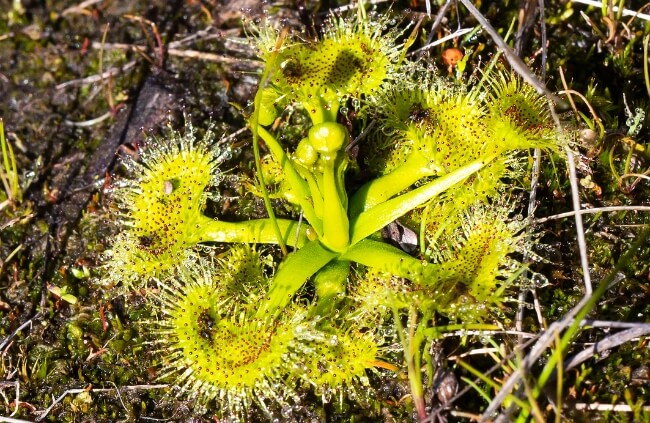
The majority of sundews around the world are native to Australia, but tuberous sundews are perhaps the most exciting of all, with thick tuberous roots that enable these carnivorous native plants to survive harsh droughts by conserving water.
In cooler months, tuberous species of Drosera develop upright, sticky, leaves and flowering spikes. The leaves catch their prey, feeding the rest of the plant and supporting the development of seed to produce new tubers.
Round-leaved sundew (Drosera rotundifolia)

Drosera rotundifolia, the round-leaved sundew, focuses its energy on the tips of its sticky leaves. Traditionally used for anti-ageing potions, these unusual insectivorous plants were once thought to be a source of eternal youth. Now we’re not promising that, but they are definitely thrilling enough to put a youthful smile on your face.
Their sticky, rounded tips, close in around their prey, encasing them in red fibrous hairs which they use to digest them over a period of about 14 days.
English sundew (Drosera anglica)
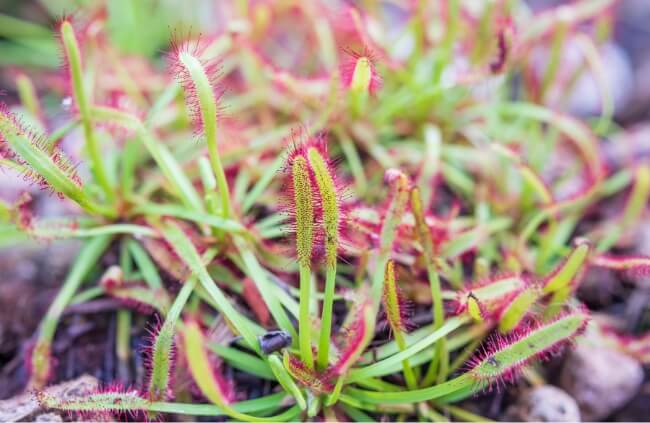
Drosera anglica, English sundew, is an unassuming marshland plant found throughout Europe, Asia and even Hawaii (though it grows with different characteristics there).
Its long leaves disguise themselves in wetlands surrounded by other flowering plants, feeding on the pollinators attracted to wet meadows.
If you’re looking for an option for cooler regions of Australia, it’s easy to manage and maintain, and will happily survive a frost.
Spoon-leaved sundew (Drosera spatulata)

The creatively named Drosera spatulata, or spoon-leaved sundew develops wonderful low-growing rosettes, completely covered in sticky red hairs, creating a mesmerising glow of frothy dew.
It’s easy to spot when it’s caught something too, as the open form of the plant is interrupted with an inwardly curled tip, which will open back out once the prey is digested.
Bladderwort (Utricularia)

Bladderwort functions similarly to pitcher plants, with cupped underwater bladders, that are triggered to catch their prey on touch. They thrive in swamps and lakes, with some species known to float independently without any soil, and other species rooting into rock but growing in search of puddles and pools to surreptitiously catch trapped insects.
The bladders that give them their name form vacuums, and when insects pass by the plants rapidly suck them in before digesting them, so insects don’t even need to enter the cups to become trapped.
Large Floating Bladderwort (Utricularia inflata)

Source: Go Botany - Native Plant Trust
These aquatic bladderworts are also known as Inflated Bladderwort or swollen bladderwort, and they do literally float across ponds, requiring no anchorage in the soil or base of the water.
Their web of leaves support flowering stems, with vibrant yellow flowers, but beneath the water surface is a network of bladder traps, catching any unsuspecting insect that passes by.
Common bladderwort (Utricularia vulgaris)
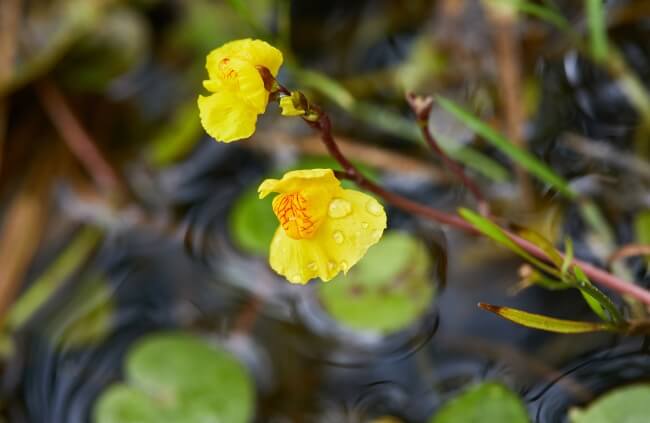
Utricularia vulgaris, the common bladderwort, grows throughout Asia and Europe, and is a wonderful plant for collections if you can provide the right conditions for them.
While they won’t exactly rid your home of pests, and require outdoor pond conditions to gather their natural prey, their flowers are beautiful, and make a great addition to ponds so are well worth growing if you can.
Sanderson’s bladderwort (Utricularia sandersonii)
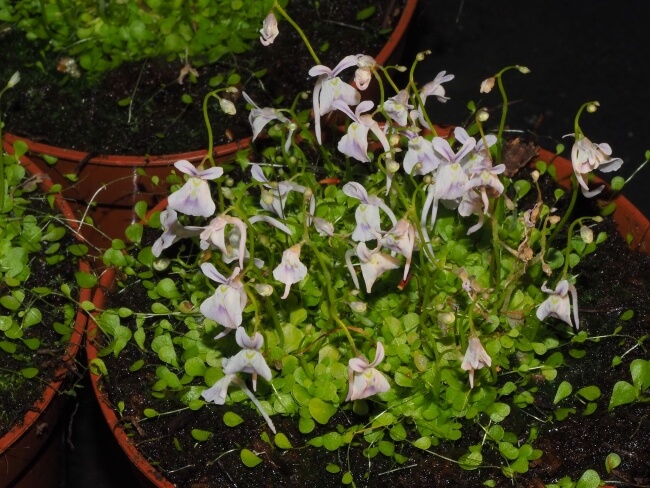
Source: Plants of the World Online
Utricularia sandersonii, or Sanderson’s bladderwort, is a ground-dwelling bladderwort, trapping creatures in saturated soil in exactly the same way as floating bladderwort does.
Its subtle white flowers look like tiny rabbits, with two protruding petals over a widening lower petal, which makes them a wonderful ornamental plant for raised bog gardens in particular.
Violet bladderwort (Utricularia purpurea)

Source: Go Botany - Native Plant Trust
One of the most stunning bladderworts, particularly for gardeners who strive for beauty in their plants as well as function, is Utricularia purpurea, the violet bladderwort.
It thrives in shallow water, and works beautifully in ponds as a result, offering a brilliant alternative to waterlilies, with just as much ornamental value.
The wide spreading roots, packed with bladders to catch things like mosquito larvae, form a dense mat of safe havens for larger amphibians, while above ground, the flowers offer nectar to pollinators. There are few better plants to maintain the overall biodiversity of pond life in your garden than violet bladderwort.
Utricularia bisquamata ‘Betty's Bay’

Source: Hewitt-Cooper Carnivorous Plants
A particularly beautiful bladderwort for indoor growers in Utricularia ‘Betty’s Bay’, a cultivar of Utricularia bisquamata, which grows on saturated compost, sphagnum moss, and pretty much any boggy soil. It feeds on soil bacteria, but will survive quite well on balanced houseplant fertiliser too.
Oyster mushroom (Pleurotus ostreatus)

Oyster mushrooms are found all over the world in temperature regions and subtropical forests, where they grow on both living and dead wood. Their root-like network of mycelium travels down into the soil, producing miles of fibrous mycelium which kills and digests nematodes as a source of nitrogen.
Their relationship with their tree hosts is beneficial for both, through controlling potentially harmful nematodes, but also by providing a shared moisture resource, and information to the trees through their interconnected roots.
The science of these relationships is young, but mycelium networks between fungi and trees are a fascinating subject, and never more so than with these widely cultivated carnivorous mushrooms that you can grow easily at home.
How to Grow Carnivorous Plants
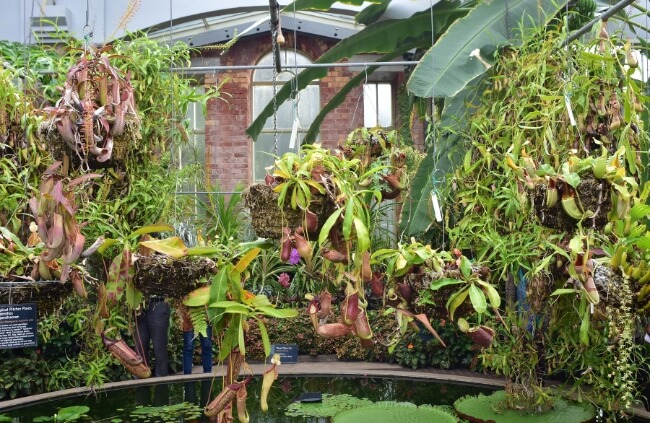
Tips for growing carnivorous plants indoors
Most carnivorous plants are moisture-loving tropical plants that need good humidity levels and moist roots. The easiest way to provide those conditions indoors, without over-humidifying your home, is a terrarium, using a large, covered glass tank.
However, if you really want to enjoy your carnivorous plants, hiding them away behind glass isn’t ideal. Alternatively, you can place a saucer beneath each container so that the soil remains damp. It also gives a great indication that you need to water.
Just give them a generous drink when the water in the saucer runs out. Make sure your carnivorous plants are somewhere warm and bright to balance water consumption with evaporation and avoid any rot in the compost.
Tips for growing carnivorous plants outdoors
Carnivorous plants grown outdoors do best in boggy conditions, or as humid epiphytes. There are several Australian natives that will work well hung from verandas and pergolas, or attached to living trees – just remember to mist them regularly during hot weather, and make sure they are shaded from afternoon sun.
Step 1: To create a free-standing bog garden, without amending your garden soil, build a simple raised bed or trough, and line it with plastic (an old compost bag will do). Pierce a few holes in the base so the water can drain slowly, and then fill the planter with moisture-retentive compost.
Step 2: There’s no need to add any topsoil or loam, but you can lighten the mixture with perlite, which will help to aerate the boggy mixture.
Step 3: Half-fill the container with the compost mix and soak it thoroughly, then add more compost to the surface and plant carnivorous plants directly into it.
Step 4: Water the surface well, and then wet it if the top 2 inches of soil ever feel remotely dry.
How to Care for Carnivorous Plants
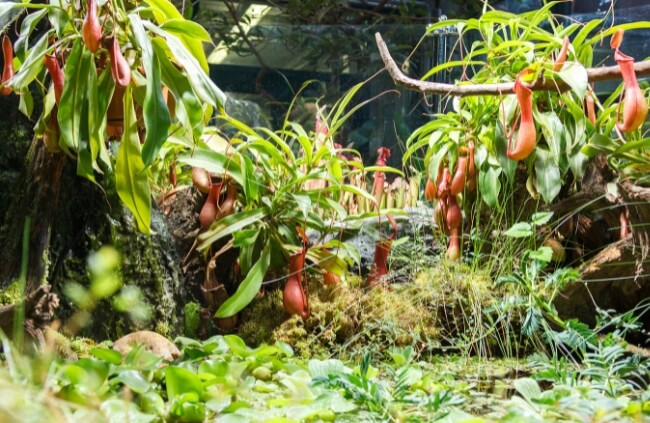
What Do Carnivorous Plants Eat
Carnivorous plants eat insects. There are a handful that eat small mammals or birds, but they are protected and endangered species, and other than a few conservation collections, only exist in the wild.
Carnivorous plants you grow at home should be allowed to feed on insects and flies and can be fed with dead flies or insects you find in the garden too. However, there are some handy fertilisers available that help to maintain their overall health when insects aren’t readily available.
How to Feed Carnivorous Plants
Carnivorous plants, either indoors or outdoors, have growing seasons based on light levels as well as temperature. They will go dormant through winter, and most will begin that dormancy in early autumn.
Avoid feeding carnivorous plants at all during those dormant periods, and feed them sparsely (every 2-3 weeks) through spring and summer.
Feeding carnivorous plants with mealworms
Dried mealworms (available at any pet shop) can be fed directly into the mouths of carnivorous plants, or into the sappy hairs.
To feed pitcher plants, simply drop one or two dried mealworms into their cups every 2-3 weeks. For sundews and butterworts, you can place mealworms directly onto their hairs, but they rarely need it as they will catch the smallest insects pretty regularly.
Venus flytraps, or snapping carnivorous plants, need to feed quite precisely. Feed them once a fortnight with a couple of mealworms by dropping them gently into the trap. They close after the second touch, so move the mealworm with tweezers after placing it to trigger the trap.
Feeding carnivorous plants with spray fertilisers
Using heavily diluted liquid seaweed, you can feed carnivorous plants by dropping or spraying fertiliser directly into the cups. Mix a ratio of 95% water to 5% liquid seaweed plant food into a bottle, and either spray or syringe a couple of drops per trap every couple of weeks.
This isn’t as good as mealworms, but will provide an alternative nutrient source that works.
Common Growing Problems with Carnivorous Plants
Carnivorous plants like damp conditions, but if the water is not used and replenished, bacteria and funguses can thrive in the soil. It’s important to find a balance of damp conditions, with aeration, and either drainage or evaporation to maintain moisture without causing root rot.
Venus flytraps are the most susceptible to root rot, so it’s important to add perlite to the potting mix to aerate the soil and help with drainage. Perlite won’t reduce the water retention of the compost in the mixture, but it will promote excess water to run off or evaporate.
The only other regular problem with growing carnivorous plants is a lack of food. Outdoor carnivorous plants will catch their own food quite happily, but indoor plants should be fed once every 2-3 weeks if there aren’t any bugs around.
They can survive for months without eating, but they will grow noticeably slower in summer if they get hungry.
Carnivorous Plants Frequently Asked Questions
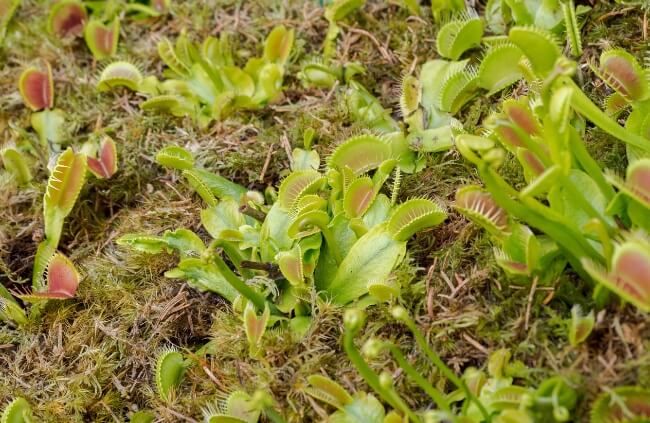
What is the easiest carnivorous plant to grow?
Sundews are the easiest carnivorous plants to grow. They look beautiful, and produce copious amounts of nectar, which actively attracts and traps their prey, meaning they very rarely need feeding or intervention from us.
Are there any hardy carnivorous plants?
Most carnivorous plants are tropical or subtropical species, so need protection from frosts, but there are plenty of cold hardy species within the Sarracenia and Drosera genera, which will happily survive frosts outdoors.
What are the most effective fly eating plants?
Pitcher plants (Sarracenia) are the most effective fly eating plants both indoors and outdoors. They require regular watering, and good moisture levels, regardless of species, so epiphytic fly traps should be kept misted and humidified to support their fly catching skills.
What are the best pots for carnivorous plants?
It’s best to keep carnivorous plants in plastic containers. Terracotta or stone containers allow water to pass through their walls, so dry out faster than is ideal. If you do grow carnivorous plants in terracotta pots, keep a saucer beneath the pot to retain moisture.
How long does it take carnivorous plants to digest a fly?
Most carnivorous plants take 7-10 days to fully digest a fly. Venus fly traps are the easiest to keep track of as they will be closed when they have caught something, as enzymes are breaking down and dissolving their prey.
Can you use tap water for carnivorous plants?
You can use tap water for carnivorous plants, but they much prefer rainwater or distilled water. If using tap water, run it through a filter before using it, to remove impurities and some water additives.
Is it safe to touch a Venus fly trap?
It is safe to touch a Venus fly trap as it won’t harm you, but you should avoid doing so as it wastes the plant’s energy. Snapping shut is a fairly strenuous action for a flytrap, and if they do it without catching something they do sulk (not literally, but if you do poke them, feed them afterwards to make up for it).
Wrapping Up Our Guide to Growing Carnivorous Plants in Australia
We’ve only ever grown a handful of carnivorous plants at home, but they are some of our most prized possessions. Not only are they utterly beautiful and mystifying, but they actively attract and control mosquitoes, which are becoming a more and more common problem in our garden.
The Venus fly traps we grow indoors enjoy the more controlled conditions, and make an excellent disposal system for mealybugs, which seem to reproduce endlessly on our succulents.
There’s still so much to be learned about carnivorous plants, and by growing them in our homes, we’re supporting revivals and conservation efforts, which might prove essential in years to come.
Published on September 7, 2023 by Gary Clarke
Last Updated on September 20, 2025

